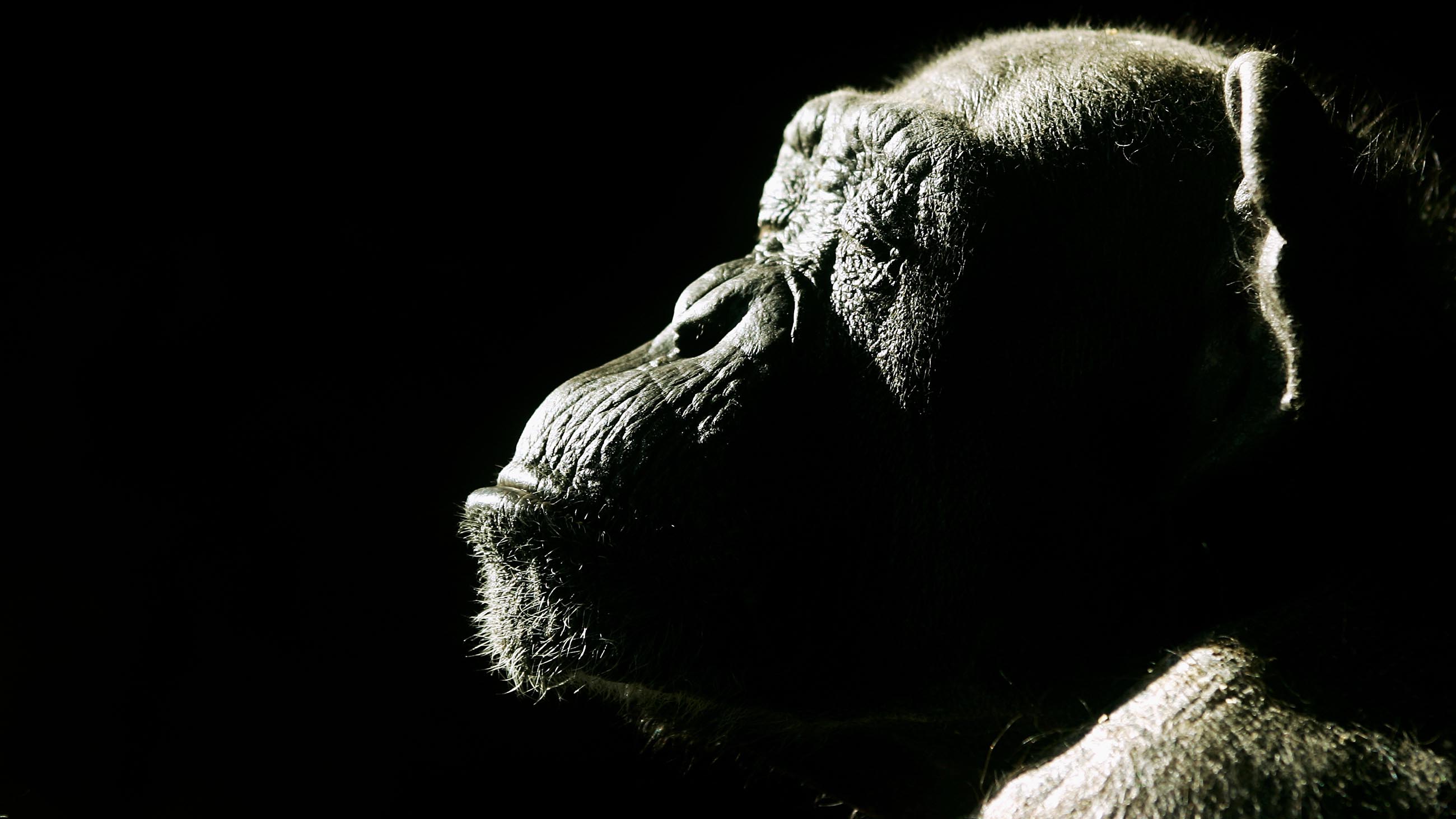Creature Comforts
Who knows what Arturo the polar bear was thinking as he paced back and forth in the dark, air-conditioned chamber behind his artificial grotto? Just down the pathway Cecilia sat quietly in her cage, contemplating whatever chimpanzees contemplate.
In recent years, both creatures, inhabitants of the Mendoza Zoological Park in Argentina, have been targets of an international campaign challenging the morality of holding animals captive as living museum exhibits. The issue is not so much physical abuse as mental abuse — the effect confinement has on the inhabitants’ minds.
Last July, a few months after I visited the zoo, Arturo, promoted by animal rights activists as “the world’s saddest polar bear,” died of what his keepers said were complications of old age. (His mantle has now been bestowed on Pizza, a polar bear on display at a Chinese shopping mall.)
But Cecilia (the “loneliest chimp,” some sympathizers have called her) has been luckier, if luck is a concept a chimpanzee can understand.
In November, Judge María Alejandra Mauricio of the Third Court of Guarantees in Mendoza decreed that Cecilia is a “nonhuman person” — one that was being denied “the fundamental right” of all sentient beings “to be born, to live, grow, and die in the proper environment for their species.”
Agreeing to a petition by animal rights lawyers in Argentina for a writ of habeas corpus — a demand that a court rule on whether a prisoner or inmate is being legally detained — the judge ordered that the chimpanzee be freed from the zoo and transferred to a great ape sanctuary in Brazil.
In an earlier case, an appeals court in Buenos Aires upheld a judge’s demand that the city zoo provide an orangutan named Sandra with a way of life consistent with her “well-being, behavioral complexity, and emotional states.”
Argentine law applies, of course, only in Argentina. But the decisions in the two cases have been taken as encouragement by activists in other countries. In the United States, the Nonhuman Rights Project has been trying for years — so far unsuccessfully — to use habeas corpus to free captive chimpanzees from labs and private zoos and have them declared nonhuman persons.
In the legal realm, a creature doesn’t necessarily have to be highly intelligent or even aware of its own existence to be recognized as a person — an entity with certain rights under the law. Corporations have been deemed “juridical persons,” and last year in New Zealand, a river revered by the Maori was declared a person, meaning that lawsuits can be filed (by people) on the river’s behalf.
But this is more than a matter of legal abstractions. No one would be fighting these battles if they didn’t believe that great apes are highly intelligent, introspective creatures experiencing some kind of inner life.

Though the science is far from settled, and probably will never be, the idea that something resembling a subjective, contemplative mind exists in other animals has become mainstream — and not just for apes. Recent popular science books include “What a Fish Knows: The Inner Lives of Our Underwater Cousins,” “The Soul of an Octopus: A Surprising Exploration Into the Wonder of Consciousness” and “Other Minds: The Octopus, the Sea, and the Deep Origins of Consciousness.”
A paper published last spring in the Proceedings of the National Academy of Sciences proposed that insects have neurological structures that may allow them to experience some kind of subjective feelings — the rudiments of a first-person perspective on the world. In “The Ancient Origins of Consciousness: How the Brain Created Experience,” Todd E. Feinberg and Jon M. Mallatt attempt to trace these anatomical clues of an inner life all the way back to the Cambrian explosion, more than half a billion years ago, when multicellular creatures — ancestors to modern animals — appeared on Earth.
The vision is of a continuum of consciousness reaching back through evolutionary time, like fins evolving to form legs, arms, feet, and hands with opposable thumbs. But no one really knows. When the objective eye of science is trained on the question of subjectivity, the evidence is always indirect and inevitably in dispute.
Some scientists propose that consciousness arose abruptly when brains, which happened to be human brains, reached a critical level of neurological complexity. Along with this evolutionary leap came language rich enough to express endlessly intricate ideas. The result was a species, unique on the planet, that is not only aware, but aware it is aware. That thinks and thinks about thinking.
By some measures, we share 99 percent of our DNA with chimpanzees. But that extra 1 percent may be crucial — extra loops of neurological wetware that give rise to the primate that calls itself Homo sapiens. Unlike the proverbial monkeys randomly typing Shakespeare, we know which keys we want to press on the typewriter, scrolling out documents and legal systems with ideas like habeas corpus and personhood.
Looking beyond the anatomical evidence, behavioral research can go only so far in illuminating the mystery. In well-known studies, chimpanzees have been trained to use simplified sign language, plastic tokens, or symbols on a keyboard for what seems like rudimentary communication. In the wild, yipping prairie dogs and dancing bees have been shown to engage in surprisingly complex signaling.
But signaling is not the same as language, and intelligence doesn’t automatically imply consciousness. The reason most of us don’t seriously believe that everyone else is a zombie is that we can share the subtleties of our inner worlds through language. Solipsists can discuss solipsism with other solipsists.
A paper published last fall in Science reported new evidence that great apes have what psychologists call a theory of mind — that they can infer another creature’s intentions from its behavior and act accordingly. That trait has also been attributed to ravens.
Other experiments indicate that great apes, dolphins, and elephants can recognize themselves in a mirror. A new paper in Proceedings of the National Academy of Sciences finds signs of mirror recognition in rhesus monkeys.
But studies like these can only cut so deep. Does the simian wonder why the reflection is like the one in a cup of water? Does it pick up the mirror and try to drink it? Does it puzzle over why, in the reflected world, left is reversed with right? Does it contemplate the past and imagine the future and know that one day it will die? For all of our advances in brain scanning and other neurological techniques, we’re stuck on the outside looking in.
Some philosophers, like Daniel Dennett, have suggested that consciousness is something that only appears collectively within a culture, where ideas clash with ideas, fracturing and combining into theories and ideologies. Evolution by genes gives way to evolution by memes.
Maybe this is just a matter of degree. Primatologists see hints of what they consider simian culture. Tribes of chimpanzees living in the wild use different methods to get honey from a log. One group uses sticks while another uses leaves — like chopsticks instead of knives and forks.
Locked into a debate with no foreseeable conclusion, what seems to be evolving in human culture is a sense of humbleness and a willingness to give other creatures the benefit of the doubt. Bowing to the pressure from activists, both the Buenos Aires and Mendoza zoos closed last year and have begun converting themselves into what are called in Spanish “ecoparques,” centers devoted to education and wildlife conservation. Many of the animals will be freed to preserves where they will no longer exist for the primary purpose of being on display.
“Animals and great apes are not objects to be exposed like a work of art created by humans,” Judge Mauricio wrote in her decision, which included quotes from Immanuel Kant, Anatole France, Buddha, and Gandhi. In agreeing to act on behalf of Cecilia, she suggested that we’re doing it for ourselves, as an expression of our humanity.
“I am convinced that if the community is duly informed and educated about the circumstances that result in my decision, it will feel the satisfaction of knowing that acting collectively as a society we have been able to give Cecilia the life she deserves,” Mauricio wrote.
“Cecilia’s present situation moves us,” she continued. “If we take care of her well-being, it is not Cecilia who will owe us; it is us who will have to thank her for giving us the opportunity to grow as a group and to feel a little more human.”
George Johnson is the author of “The Cancer Chronicles,” “The Ten Most Beautiful Experiments,” and seven other books, which have been translated into 15 languages. His column, “Raw Data,” appears in The New York Times.











Comments are automatically closed one year after article publication. Archived comments are below.
Regarding the judge’s decision that Cecilia the chimpanzee was a person under the law that was being denied the fundamental right to lie in its proper environment… I find myself fairly concerned. Some questions come to mind:
“Proper environment” implies that there is a right and a wrong when it comes to where an organism exists. Who is it that gets to decide right and wrong in this context? The ruling seems to imply that there is some sort of inherent order to the universe, from which humans are separate, and any deviation from the natural order of things is improper.
Additionally, if it is unjust to grow up in an “improper” environment… then I ask this: is it “proper” for a human being to grow up in the concrete jungle that comprises so many of our inner cities?
Ambiguities in language and inconsistencies in logic are dangerous legal precedents. I hope that this judge’s explanation for their ruling does not strike the rest of the world as satisfactory.
Hey Nicholas Russo,
You said: “Proper environment” implies that there is a right and a wrong when it comes to where an organism exists.”
Who is it that gets to decide right and wrong in this context? The ruling seems to imply that there is some sort of inherent order to the universe, from which humans are separate, and any deviation from the natural order of things is improper.”
Proper environment in this context refers to the natural habitats where one would normally encounter a chimpanzee and where a chimp would evolve, live and potentially thrive. In the court of law, “right or wrong” is an artifact of judging and the judicial process. Who gets to decide said right or wrong, the simple answer whomever is in power. With respects to chimpanzees (and animals in general) we can begin to base it upon the animals lived experience and the empirical observation of one’s own species in said habitat. Similar to how in the U.S. the constitution serves as the foundation and framework through which are evolving laws are interpreted.
Also in this context, proper environment recognizes humans took the chimp out of its natural environment for our amusement, hence the fundamental right aspect. This cannot be separated.
“The ruling seems to imply that there is some sort of inherent order to the universe, from which humans are separate, and any deviation from the natural order of things is improper.”
It seems you’ve over-interpreted the ruling as a universal decree with transcendental reasoning. The ruling simply states the chimp has rights to live in its natural environment, we violated them by removing the chimp from its environment, thus we have to make amends by moving the chimp to an environment similar to its natural environment.
“Additionally, if it is unjust to grow up in an “improper” environment… then I ask this: is it “proper” for a human being to grow up in the concrete jungle that comprises so many of our inner cities?”
Taken from the environment perspective, the concrete jungles are an habitat that society has created in which humans live and evolve. Is it a proper environment, experience and research shows no; with respects to an environment conducive to the continued survival of a human and or the potential for a human to thrive. Hence the protests, political movements for change and your utility of asking said question.
“Ambiguities in language and inconsistencies in logic are dangerous legal precedents. I hope that this judge’s explanation for their ruling does not strike the rest of the world as satisfactory.”
Philosophical and linguistic arguments can only go so far in relation to laws. Ambiguities and logical inconsistencies currently exist in law and will continue into the future. Ambiguities aren’t necessarily dangerous (unless a law is lazily written), they reflect that all lived experience can’t be directly cognized in legal proceedings. Interpretation will always be needed. Logical inconsistencies are dangerous because foundationally speaking, they run the risk of contradicting another law on the books, which potentially undermines both laws.
PF-T
Why don’t we assume animals are as smart or smarter than humans? We keep studying them until we figure it out. One day, if we allow our species to live long enough, we will figure it out. In the meantime, we will have given all other living things the benefit of a free life. And humans will not feel so badly that, out of ignorance, we treated them so poorly before we understood.
You describe your opinion about what it is to be human. There are other views, Freud for example. I wonder what your unconscious motives truly are to suggest such a wonderful evolution of human consciousness?
We notice an implicit definition:
“aware that it is aware”
Yet experience of pain and more basically, avoidance of adverse stimuli (or, importantly, avoidance and attempts to avoid lack of simulation) are of greater import than being secondarily aware that one avoids or seeks to avoid.
Senses evolved due to the advantage of attractive and avoidant stimuli over inability to detect.
It is difficult to imagine denses without integration into motor centers.
The cortical areas through which this occurs are known in general as association cortex, and very importantly, there are other pathways than those mapped linking cortical areas.
“aware that one is aware” would seem to be a reference to some kind of verbal self-narrative, a process not necessary for memory and consequent sensorimotor response. I realize that I discount some of the studies reporting lack [of report] of awareness” in human lesion and the famous “split-brain” studies of patients of the lobotomy/lobectomy era, but ability to verbally report stimuli is not the same as actual consciousness of sensory stimuli.
Both domesticated and wild mammals communicate , that is emit,, social signals, concerning desire to avoid distressful stimuli and to call others when desiring to avoid. We may infer that this specific intentionality exists, as trapped, injured, or wounded mammals tend to become silent when approached with either ameliorating or predatory intent, unless the stimulus is so great that the affected individual becomes inattentive.
This is so useful an adaptation that a distinct social consciousness becomes quite close to certainty. In less social mammals, the young retain the behavior, and so the experience of relief would also appear to be conscious, even though the calling may not itself shut down in an intentional manner.
Let’s remember that memory formation and psychological arousal occurs in areas that are not neocortex.
Some motor awareness occurs in midbrain structures as Pons and Cerebellum.
Physiological arousal can be instituted by certain humans who practice certain disciplines, but for purposes here, we can look at these as set into action through sensory stimuli as well as through hormonal and limbic stimulation. Let’s leave discussion of those aside, excpet to note that amygdalae and limbic arousal creates awareness so powerfully that it is there we should look for the functional consciousness.
Thalamic connectivity is associational and distributory, so that vital area, too should be implicated.
OK, while incomplete as a survey, let’s simplify:
I don’t know of any organism containing just a single neuron, and while I abhor some of the excesses of neurophilosophers (they seem to be solely interested in human experience, even while other animals have for untold centuries interacted with other animals obviously communicating , intending, responding to them) Two observations might be in order:
1. It takes two neurons to function; at least one sensory and at least one motor neuron. Developmental evolution occurred at an early enough stage that genetic and epigenetic functions created more than one, as they still do.
2. In spite of the misuse of the concept known as Occam’s Razor, consciousness is a more obvious characteristic useful for response to highly variable external stimuli, than is any postulatable single or limited automatic, autonomic response. While limited emissions of materials causing avoidance by other species, or attracting them to baits or deceptive leavings (think of squid ink and sea cucumbers that eject internal organs to feed predators. I’ve played with both as a child, and think of them as responding through that direct two-neuronlike reflex arc, similar to the knee-jerk reflex)
– Which reminds me of sea quirts, tunicates, that reabsorb their eyes, notochord, and the nucleus or ganglion that constitutes their brain, when they settle down to an attached, sedentary adulthood after a responsive, perhaps anxious freeswimming childhood and adolescence.
A last obsrevation: THe much-vaunted speculation concerning “Theory of Mind” while mappable inn the human brain, I would expect to look quite different in other species, such as canids, who seem to actively desire to avoid deceptive humans (captive wolves FAR moreso than neotenous variants like domestic dogs) when exposed to them for period of time long enough to evaluate the perpetrator’s intransigence. ToM experiments on human children appear merely to detect the particular stage at which the child is able to detect and act deceptively. A significant part of our species-specific brain is involved in deception, so much so, that Bob Trivers explored the idea that self-deception, a tunicate-like reversion away from consciousness, is an evolved adaptation to the massively aberrant focus of that brain upon detection of social deception.
I’ll leave them to philosophers. But since famous brains-in -a-blender neuroscientist Suzana Herculano-Houzel says:
“Brains evolved for movement”, expect consciousness to be prevalent in many taxa: fish and moray eels have been known to develop coalitional hunting strategies, as have coyotes and badgers, dolphins, wolves, dogs, and men.
Habituation is a term subsuming consciousness in some cases. The acceptance of a mule deer doe of a wildlife scientist, by which her bringing her offspring to learn to recognize him as an individual during the developmental period of receptivity; the calling to me to seemingly somehow constrain a pair of dogs from exploring her den and tiny cub, by a female Ursus americanus I knew for a decade, these are events most easily explained by conscious identification, and intentionality. Such behaviors run so counter to unassessed avoidance that I’ll stick with consiousness and await any competing idea with a skeptical eye.
I spent a decade intimately communicating with a wolf, and have been called to play by a wild dolphin (captives constantly attempt interspecies communication and interaction, including invention of games, as did that Wolf), as well as having been called and teased by two particular ravens over years , out of several bands I’ve known, although I still can’t tell them apart, except by their behavior.
(“What a bigot!”, you think. That’s ToM, btw and in my experiments, both the Wolf and I exhibit 3rd order, as this parenthetical comment shows! It’s not useful to go beyond that level, just as one South Pacific tribe counts, one, two, many. I hope I have added to your conscious understanding . . .)
Also see Virginia Morrell’s fine “Animal Wise. How we know animals think and feel” and Carl Safina’s thoughtful and well-argued “Beyond Words, What Animals Think and Feel.” This line wonderfully captures where things are moving; “what seems to be evolving in human culture is a sense of humbleness and a willingness to give other creatures the benefit of the doubt.”
A fine , wise, compassionate column and three intelligent replies. WE humans have shamefully abused most all life-forms that surround us, and are a living part of our home.
Al Farthing,
Nova Scotia Canada.
Hi, George! From a scientific perspective, the idea of consciousness in animals is extremely compelling. However, coming strictly from an animal welfare position, I don’t find it all that relevant. It’s understood beyond any question that animals do indeed feel and suffer, and that’s the point. It’s why these animals in Argentina have become the focus of public attention. Doesn’t adding consciousness to this particular equation confuse the relationship between abuse and suffering?
The Science paper you refer may simply be evidence that chimpanzees understand behavior not intentions.
http://science.sciencemag.org/content/354/6308/110/tab-e-letters
I agree about the group (clan/tribe) allocation of human values and responsibilities. Other animals operate similarly when deviants are punished, ostracized, or killed. While hunting or the ‘humane’ raising of livestock for food doesn’t bother me, caging animals for display does. I should add that it the inordinate success of our species ( 400% increase in a century) that is devastating biodiversity and toxifying the planet with our waste.